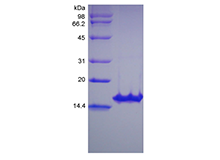- Synonyms
- ATF, ATF-1
- Source
- Escherichia coli.
- Molecular Weight
- Approximately 30.1 kDa, a homodimeric protein consisting of two 134 amino acid non-glycosylated polypeptide chains.
- AA Sequence
- SPDKQMAVLP RRERNRQAAA ANPENSRGKG RRGQRGKNRG CVLTAIHLNV TDLGLGYETK EELIFRYCSG SCDAAETTYD KILKNLSRNR RLVSDKVGQA CCRPIAFDDD LSFLDDNLVY HILRKHSAKR CGCI
- Purity
- > 95% by SDS-PAGE analyse.
- Biological Activity
- Fully biologically active when compared to standard. The ED50 as determined by a cell proliferation assay using rat C6 cells is less than 0.1 ng/ml, corresponding to a specific activity of > 5.0 × 107 IU/mg.
- Physical Appearance
- Sterile Filtered White lyophilized (freeze-dried) powder.
- Formulation
- Lyophilized from a 0.2 μm filtered concentrated solution in 1 × PBS, pH 7.4, with 0.05 % Tween-20.
- Endotoxin
- Less than 0.1 EU/μg of rHuGDNF as determined by LAL method.
- Reconstitution
- We recommend that this vial be briefly centrifuged prior to opening to bring the contents to the bottom. Reconstitute in sterile distilled water or aqueous buffer containing 0.1 % BSA to a concentration of 0.1-1.0 mg/mL. Stock solutions should be apportioned into working aliquots and stored at ≤ -20 °C. Further dilutions should be made in appropriate buffered solutions.
- Stability & Storage
- Use a manual defrost freezer and avoid repeated freeze-thaw cycles.
- 12 months from date of receipt, -20 to -70 °C as supplied.
- 1 month, 2 to 8 °C under sterile conditions after reconstitution.
- 3 months, -20 to -70 °C under sterile conditions after reconstitution.
- Usage
- This material is offered by Shanghai PrimeGene Bio-Tech for research, laboratory or further evaluation purposes. NOT FOR HUMAN USE.
- SDS-PAGE

- Reference
- 1. Wood MD, Kim H, Bilbily A, et al. 2012. Muscle Nerve, 46: 122-4.
2. Stahl K, Mylonakou MN, Skare O, et al. 2011. Brain Res, 1378: 105-18.
3. Cornejo M, Nambi D, Walheim C, et al. 2010. Neurochem Res, 35: 1643-51.
4. Boado RJ, Zhang Y, Wang Y, et al. 2008. Biotechnol Bioeng, 100: 387-96.
- Background
- Glial cell-derived neurotrophic factor is a neurotrophic factor that enhances survival and morphological differentiation of dopaminergic neurons and increases their high-affinity dopamine uptake. It is a founding member of the GDNF family of ligands (GFL) and has been shown to interact with GFRA2 and GDNF family receptor alpha. GDNF (monomer) contains seven conserved cysteine residues, one of which (Cys 101) is used for inter-chain disulfide bridging and the others are involved in intramolecular ring formation known as the cysteine knot configuration. Rat and human mature GDNF shows 93 % sequence identity and have species cross-reactivity.










 COA Application
COA Application


